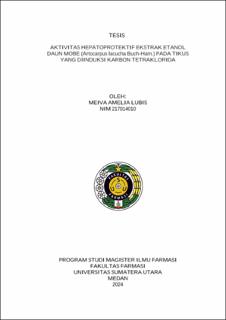Aktivitas Hepatoprotektif Ekstrak Etanol Daun Mobe (Artocarpus lacucha Buch-Ham.) pada Tikus yang Diinduksi Karbon Tetraklorida
Hepatoprotective Effect of Ethanol Extract of Mobe Leaves (Artocarpus lacucha Buch-Ham.) Against Carbon Tetrachloride Induced Hepatotoxicity in Rats

Date
2024Author
Lubis, Meiva Amelia
Advisor(s)
Dalimunthe, Aminah
Sitorus, Panal
Metadata
Show full item recordAbstract
Liver is the most critical organ in the body's metabolic systems, which is detoxification of biological compounds and xenobiotic causing liver damage. Carbon tetrachloride (CCl4) is a xenobiotic commonly used to induce lipid peroxidation and causing liver damage. Antioxidants are required to reduce free Radicals. Mobe Leaves (Artocarpus lacucha Buch-Ham.) includes secondary metabolites in the form of flavonoids, which have antioxidant characteristics, hence it has the ability to protect the liver from harm. The purpose of this study is to investigate the hepatoprotective efficacy of an ethanol extract of Mobe Leaves (Artocarpus lacucha Buch-Ham.) against rats induced with Carbon tetrachloride (CCl4).
In this study, 30 rats were divided into 6 treatment groups:, ethanol extract of Mobe leaves (50,100, 200 dan 400 mg/Kg BW), the Silymarin control group 100 mg/Kg BW, CMC Na 1% control group which was induced by CCl4 on days 7 and
14. After a certain treatment period, liver biomarker parameters (TB, ALT, AST), liver macropathy (color, consistency, shape of liver), liver histology (hydrophobic degeneration, necrosis, inflammation) and immunohistochemistry (SOD-1, TNF-α, IL-6, Caspase-3) were evaluated to assess the hepatoprotective effects of EEDM. One way ANOVA was used to evaluate the data, followed by Post Hoc Turkey.
The study results of EEDM 400 mg/Kg BW showed hepatoprotective effect agains liver damage induced by CCl4, which was reduced TB, ALT, AST with a significant difference (p<0.05) against the CMC Na group 1% as a negative control. The macroscopic of liver observation showed improved liver macropathy color, consistency, shape of liver with difference against the CMC Na group 1% as a negative control. The microscopic of liver histology observation showed improved hepatocyte liver hydrophobic degeneration, necrosis, inflammation with difference against the CMC Na group 1% as a negative control. The microscopic of immunohistochemistry observation showed improved expression of SOD-1 and reduce expression of TNF-α, IL-6, Caspase-3 with difference against the CMC Na group 1% as a negative control. Thus, EEDM has the potential as an effective hepatoprotective agent in liver disease treatment.
Collections
- Magister Theses [371]
